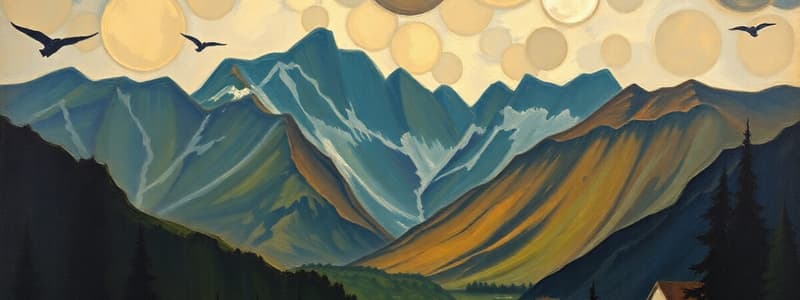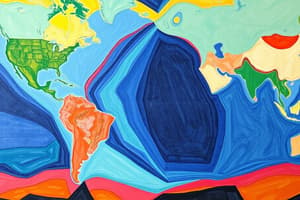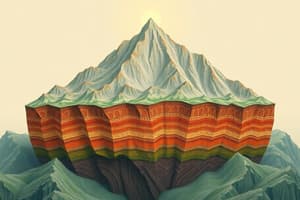Podcast
Questions and Answers
What mechanism is primarily responsible for the movement of tectonic plates due to the subduction of denser oceanic plates?
What mechanism is primarily responsible for the movement of tectonic plates due to the subduction of denser oceanic plates?
- Magnetic drift
- Ridge push
- Slab pull (correct)
- Mantle convection
Which of the following consequences of plate tectonics is directly related to the movement of magma?
Which of the following consequences of plate tectonics is directly related to the movement of magma?
- Earthquakes
- Volcanism (correct)
- Climate change
- Mountain building
How does ridge push contribute to plate movement?
How does ridge push contribute to plate movement?
- By generating earthquakes at subduction zones
- By creating volcanic islands
- By causing the lithosphere to slide downhill (correct)
- By altering the composition of the upper mantle
Which piece of evidence supports the theory of plate tectonics by demonstrating the alignment of geological features across continents?
Which piece of evidence supports the theory of plate tectonics by demonstrating the alignment of geological features across continents?
What impact does plate tectonics have on global climate patterns?
What impact does plate tectonics have on global climate patterns?
What occurs at divergent plate boundaries?
What occurs at divergent plate boundaries?
Which type of convergence results in the formation of volcanic island arcs?
Which type of convergence results in the formation of volcanic island arcs?
What evidence supports the theory of plate tectonics regarding the fit of continents?
What evidence supports the theory of plate tectonics regarding the fit of continents?
Which of the following is a result of transform plate boundaries?
Which of the following is a result of transform plate boundaries?
What role do magnetic stripes play in supporting plate tectonics?
What role do magnetic stripes play in supporting plate tectonics?
Which type of convergence leads to the formation of the Andes Mountain range?
Which type of convergence leads to the formation of the Andes Mountain range?
What does paleoclimatic evidence of glacial deposits indicate?
What does paleoclimatic evidence of glacial deposits indicate?
How is seafloor spreading directly related to plate tectonics?
How is seafloor spreading directly related to plate tectonics?
Flashcards
Plate Tectonics
Plate Tectonics
The theory describing large-scale movement of Earth's lithosphere.
Divergent Boundary
Divergent Boundary
Plates moving apart, creating new crust.
Convergent Boundary
Convergent Boundary
Plates colliding; outcome depends on plate type.
Transform Boundary
Transform Boundary
Signup and view all the flashcards
Continental-Continental Convergence
Continental-Continental Convergence
Signup and view all the flashcards
Seafloor Spreading
Seafloor Spreading
Signup and view all the flashcards
Evidence for Plate Tectonics
Evidence for Plate Tectonics
Signup and view all the flashcards
Plate Boundaries
Plate Boundaries
Signup and view all the flashcards
Plate Movement
Plate Movement
Signup and view all the flashcards
Mantle Convection
Mantle Convection
Signup and view all the flashcards
Slab Pull
Slab Pull
Signup and view all the flashcards
Plate Boundary Earthquakes
Plate Boundary Earthquakes
Signup and view all the flashcards
Volcanic Activity
Volcanic Activity
Signup and view all the flashcards
Study Notes
Plate Tectonics Theory
- Plate tectonics is a fundamental theory in geology that describes the large-scale motion of Earth's lithosphere.
- The lithosphere is broken into several large and small plates that move relative to each other over the underlying asthenosphere.
Types of Plate Boundaries
- Divergent Boundaries: Plates move apart, creating new crust. Magma rises to the surface, forming volcanoes and mid-ocean ridges. Examples include the Mid-Atlantic Ridge and Iceland.
- Convergent Boundaries: Plates collide. The outcome depends on the type of plates involved:
- Oceanic-continental convergence: Oceanic plate subducts beneath the continental plate, forming a trench and volcanic mountain range (e.g., Andes).
- Oceanic-oceanic convergence: One oceanic plate subducts beneath another, creating volcanic island arcs (e.g., Japan).
- Continental-continental convergence: Two continental plates collide, creating large mountain ranges (e.g., Himalayas).
- Transform Boundaries: Plates slide past each other horizontally. Friction and stress build up, leading to earthquakes (e.g., San Andreas Fault).
Evidence Supporting Plate Tectonics
- Fit of Continents: The continents appear to fit together like puzzle pieces, especially along the coastlines. This observation first suggested continental drift.
- Fossil Evidence: Similar fossils of plants and animals are found on continents now separated by vast oceans. This supports the idea of landmasses once being connected.
- Geological Evidence: Matching rock types and mountain ranges are found across continents, indicating past connections.
- Paleoclimatic Evidence: Glacial deposits are found in areas that are currently tropical. This demonstrates shifts in the positions of continents relative to the poles over time.
- Magnetic Stripes: The ocean floor has symmetrical patterns of magnetic stripes, reflecting reversals in Earth's magnetic field. These stripes show the spreading of the seafloor, a key component of plate tectonics.
- Earthquake and Volcano Distribution: Earthquakes and volcanic activity are concentrated along plate boundaries. This pattern provides strong evidence about plate movement.
- Seafloor Spreading: Measurements of seafloor spreading rates show consistent movement of plates apart or against each other. New oceanic crust is formed at mid-ocean ridges, pushing older crust outwards, and supporting the plate motion process.
- GPS Technology: Modern GPS technology allows for precise measurements of plate movement, providing direct observational evidence of plate motion.
Mechanisms Driving Plate Movement
- Mantle Convection: Heat from the Earth's core causes convection currents in the mantle. These currents move the plates, carrying them along and driving plate movement.
- Slab Pull: As denser oceanic plates subduct, they pull the rest of the plate along.
- Ridge Push: Magma rising at mid-ocean ridges creates a slope, causing the lithosphere to slide downhill.
Consequences of Plate Tectonics
- Earthquakes: Friction and stress at plate boundaries lead to earthquakes.
- Volcanism: Volcanic activity is concentrated at plate boundaries due to magma rising from the mantle.
- Mountain Building: Collisions between plates result in mountain ranges.
- Seafloor Spreading/Creation of Ocean Basins: Divergent plate boundaries create new ocean floor.
- Climate Change: Plate movement influences the distribution of continents and oceans, impacting global climate patterns.
Summary
- Plate tectonics is a unifying theory in geology, explaining the large-scale movements of Earth's lithosphere.
- Evidence for the theory includes the fit of continents, matching fossils, geological features, paleoclimate data, magnetic stripes on the seafloor, earthquake and volcanic activity distribution, seafloor spreading, and modern GPS technology.
- Mechanisms driving plate movement include mantle convection, slab pull, and ridge push.
- The consequences of plate tectonics are diverse, impacting earthquakes, volcanoes, mountain building, ocean basin formation, and global climate change.
Studying That Suits You
Use AI to generate personalized quizzes and flashcards to suit your learning preferences.




